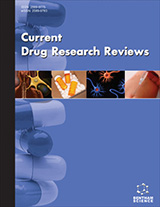
Abstract
The Endocannabinoid System (ECS) is a well-studied system that influences a variety of physiological activities. It is evident that the ECS plays a significant role in metabolic activities and also has some neuroprotective properties. In this review, we emphasize several plant-derived cannabinoids such as β-caryophyllene (BCP), Cannabichromene (CBC), Cannabigerol (CBG), Cannabidiol (CBD), and Cannabinol (CBN), which are known to have distinctive modulation abilities of ECS. In Alzheimer's disease (AD), the activation of ECS may provide neuroprotection by modulating certain neuronal circuitry pathways through complex molecular cascades. The present article also discusses the implications of cannabinoid receptors (CB1 and CB2) as well as cannabinoid enzymes (FAAH and MAGL) modulators in AD. Specifically, CBR1 or CB2R modulations result in reduced inflammatory cytokines such as IL-2 and IL-6, as well as a reduction in microglial activation, which contribute to an inflammatory response in neurons. Furthermore, naturally occurring cannabinoid metabolic enzymes (FAAH and MAGL) inhibit the NLRP3 inflammasome complex, which may offer significant neuroprotection. In this review, we explored the multi-targeted neuroprotective properties of phytocannabinoids and their possible modulations, which could offer significant benefits in limiting AD.
Graphical Abstract
[http://dx.doi.org/10.1016/j.cub.2018.04.080] [PMID: 29870699]
[http://dx.doi.org/10.5114/fn.2013.37702] [PMID: 24114635]
[http://dx.doi.org/10.1016/j.jalz.2016.06.001] [PMID: 27436677]
[http://dx.doi.org/10.1016/j.neuron.2009.03.024] [PMID: 19376066]
[http://dx.doi.org/10.1038/nj7526-299a] [PMID: 25396246]
[http://dx.doi.org/10.1016/j.clinbiochem.2019.04.010] [PMID: 31018113]
[http://dx.doi.org/10.1016/j.celrep.2019.03.099] [PMID: 31018141]
[http://dx.doi.org/10.1212/01.WNL.0000152982.47274.9E] [PMID: 15753419]
[http://dx.doi.org/10.3233/JAD-180005] [PMID: 29710717]
[http://dx.doi.org/10.31744/einstein_journal/2020AO4752] [PMID: 31664323]
[http://dx.doi.org/10.1016/0197-4580(95)00021-6] [PMID: 7566337]
[http://dx.doi.org/10.1016/j.conb.2015.10.004] [PMID: 26517285]
[http://dx.doi.org/10.1016/j.biopsych.2015.07.028] [PMID: 26698193]
[http://dx.doi.org/10.3390/ijms19030833] [PMID: 29533978]
[http://dx.doi.org/10.1007/978-3-540-88955-7_14] [PMID: 21104391]
[http://dx.doi.org/10.1016/j.biopha.2020.110889] [PMID: 33113429]
[PMID: 19675519]
[http://dx.doi.org/10.3389/fpls.2016.00019] [PMID: 26870049]
[http://dx.doi.org/10.31887/DCNS.2007.9.4/nkogan] [PMID: 18286801]
[http://dx.doi.org/10.1590/S0100-879X2006000400001] [PMID: 16612464]
[http://dx.doi.org/10.1111/j.1365-2990.2011.01248.x] [PMID: 22236282]
[http://dx.doi.org/10.3233/JAD-140093] [PMID: 25024327]
[http://dx.doi.org/10.1016/j.febslet.2004.10.064] [PMID: 15556647]
[http://dx.doi.org/10.1074/jbc.M601074200] [PMID: 16547349]
[http://dx.doi.org/10.3389/fncel.2018.00072] [PMID: 29618972]
[http://dx.doi.org/10.1016/B978-0-12-802395-2.00021-3] [PMID: 28987178]
[http://dx.doi.org/10.1038/s41419-020-02824-z] [PMID: 32826878]
[http://dx.doi.org/10.2174/157488909788453031] [PMID: 19519560]
[http://dx.doi.org/10.1007/s40261-016-0379-x] [PMID: 26892745]
[http://dx.doi.org/10.1016/j.ajpath.2011.11.003] [PMID: 22155112]
[http://dx.doi.org/10.1016/j.tips.2016.04.005] [PMID: 27179600]
[http://dx.doi.org/10.1016/j.fct.2005.08.028] [PMID: 16226832]
[http://dx.doi.org/10.2174/1381612822666160311115226] [PMID: 26965491]
[http://dx.doi.org/10.1073/pnas.0803601105] [PMID: 18574142]
[http://dx.doi.org/10.4161/cib.1.1.6568] [PMID: 19704783]
[http://dx.doi.org/10.1016/j.cbi.2010.07.009] [PMID: 20638373]
[http://dx.doi.org/10.1016/j.bbr.2019.112439] [PMID: 31862467]
[http://dx.doi.org/10.3390/cancers12041038] [PMID: 32340197]
[http://dx.doi.org/10.1016/j.euroneuro.2013.10.008] [PMID: 24210682]
[http://dx.doi.org/10.3390/molecules25010106] [PMID: 31892132]
[http://dx.doi.org/10.3390/biomedicines8060164] [PMID: 32560286]
[http://dx.doi.org/10.1371/journal.pone.0216104] [PMID: 31841509]
[http://dx.doi.org/10.1089/jmf.2019.0111] [PMID: 31663807]
[http://dx.doi.org/10.1016/j.bbr.2019.112012] [PMID: 31173795]
[http://dx.doi.org/10.1016/j.biopha.2018.11.039] [PMID: 30469079]
[http://dx.doi.org/10.3389/fnins.2016.00321] [PMID: 27531971]
[http://dx.doi.org/10.1016/j.biortech.2007.07.050] [PMID: 17826984]
[http://dx.doi.org/10.1016/j.heliyon.2019.e01915] [PMID: 31245644]
[http://dx.doi.org/10.1016/j.jep.2006.02.001] [PMID: 16540272]
[http://dx.doi.org/10.1016/B978-0-12-800213-1.00062-6]
[http://dx.doi.org/10.1016/0163-7258(88)90106-4] [PMID: 3279430]
[http://dx.doi.org/10.1007/978-3-030-61286-3]
[http://dx.doi.org/10.1039/C6NP00074F] [PMID: 27722705]
[http://dx.doi.org/10.1093/genetics/163.1.335] [PMID: 12586720]
[http://dx.doi.org/10.1111/j.1476-5381.2011.01238.x] [PMID: 21749363]
[http://dx.doi.org/10.1073/pnas.95.14.8268] [PMID: 9653176]
[http://dx.doi.org/10.1111/j.1572-0241.2002.05852.x] [PMID: 12190187]
[http://dx.doi.org/10.1136/thx.31.6.720] [PMID: 797044]
[http://dx.doi.org/10.1055/s-2006-960231]
[http://dx.doi.org/10.1016/0091-3057(91)90349-7] [PMID: 1666911]
[http://dx.doi.org/10.1016/j.plipres.2011.01.001] [PMID: 21295074]
[http://dx.doi.org/10.1242/jeb.200.6.1047] [PMID: 9318858]
[http://dx.doi.org/10.1021/jm970126f] [PMID: 9379442]
[http://dx.doi.org/10.1021/np8002673] [PMID: 18681481]
[http://dx.doi.org/10.1300/J175v01n03_08]
[http://dx.doi.org/10.1159/000136944] [PMID: 1221432]
[http://dx.doi.org/10.1021/np50008a001] [PMID: 6991645]
[http://dx.doi.org/10.1016/j.jdermsci.2006.10.009] [PMID: 17157480]
[http://dx.doi.org/10.1523/JNEUROSCI.0504-08.2008] [PMID: 18550765]
[http://dx.doi.org/10.1093/acprof:oso/9780199662685.003.0002]
[http://dx.doi.org/10.1006/bbrc.2001.4354] [PMID: 11181068]
[http://dx.doi.org/10.1016/j.archoralbio.2018.03.010] [PMID: 29609053]
[PMID: 959665]
[http://dx.doi.org/10.3181/00379727-180-42181]
[http://dx.doi.org/10.1111/j.1476-5381.1973.tb08262.x] [PMID: 4787563]
[http://dx.doi.org/10.1101/cshperspect.a001651] [PMID: 20457564]
[http://dx.doi.org/10.1016/S0361-9230(98)00099-9] [PMID: 10052571]
[http://dx.doi.org/10.1007/s10681-008-9787-1]
[http://dx.doi.org/10.1111/j.1476-5381.2009.00515.x] [PMID: 20002104]
[http://dx.doi.org/10.1007/s11481-009-9177-z] [PMID: 19847654]
[PMID: 168349]
[http://dx.doi.org/10.3390/ijms19071992] [PMID: 29986533]
[http://dx.doi.org/10.3389/fnins.2016.00406] [PMID: 27679556]
[http://dx.doi.org/10.1111/j.2042-7158.2011.01384.x] [PMID: 22309263]
[http://dx.doi.org/10.1016/S0040-4020(01)99445-1]
[http://dx.doi.org/10.1111/j.1556-4029.2010.01441.x] [PMID: 20487147]
[http://dx.doi.org/10.1371/journal.pone.0070052] [PMID: 23894589]
[http://dx.doi.org/10.1248/cpb.59.1409] [PMID: 22041081]
[http://dx.doi.org/10.1111/bph.14815] [PMID: 31368508]
[http://dx.doi.org/10.1016/0041-008X(79)90250-3] [PMID: 494278]
[http://dx.doi.org/10.1038/nn.2685] [PMID: 21076424]
[http://dx.doi.org/10.1016/j.neuron.2011.11.015] [PMID: 22284188]
[http://dx.doi.org/10.1038/nn.2684] [PMID: 21076423]
[http://dx.doi.org/10.1124/mol.114.094649] [PMID: 25106425]
[http://dx.doi.org/10.1111/j.1476-5381.2010.00729.x] [PMID: 20590558]
[http://dx.doi.org/10.1016/j.brainres.2005.11.035] [PMID: 16472786]
[http://dx.doi.org/10.1073/pnas.1118167109] [PMID: 22331871]
[http://dx.doi.org/10.1177/1073858410373281]
[http://dx.doi.org/10.1523/JNEUROSCI.19-11-04544.1999] [PMID: 10341254]
[http://dx.doi.org/10.1007/3-540-26573-2_10] [PMID: 16596779]
[http://dx.doi.org/10.1016/S0306-4522(97)00436-3] [PMID: 9460749]
[http://dx.doi.org/10.1016/j.neuron.2016.01.023] [PMID: 26898775]
[http://dx.doi.org/10.1016/j.tips.2015.02.008] [PMID: 25796370]
[http://dx.doi.org/10.1096/fj.06-7957com] [PMID: 17704191]
[http://dx.doi.org/10.1038/nn.2632] [PMID: 20852626]
[http://dx.doi.org/10.1038/346561a0] [PMID: 2165569]
[http://dx.doi.org/10.1038/365061a0] [PMID: 7689702]
[http://dx.doi.org/10.1021/jm031019q] [PMID: 14736243]
[http://dx.doi.org/10.1016/j.tetlet.2011.01.068]
[http://dx.doi.org/10.1016/j.tet.2008.09.057]
[http://dx.doi.org/10.1007/s12035-015-9154-x] [PMID: 25833102]
[http://dx.doi.org/10.1016/0091-3057(93)90481-8] [PMID: 8383342]
[http://dx.doi.org/10.3238/arztebl.2009.0464] [PMID: 19652769]
[http://dx.doi.org/10.1111/j.1476-5381.2009.00582.x] [PMID: 20100276]
[http://dx.doi.org/10.1038/nn.2616] [PMID: 20729846]
[http://dx.doi.org/10.1523/JNEUROSCI.0847-08.2008] [PMID: 19074027]
[http://dx.doi.org/10.1038/nature02913] [PMID: 15372034]
[http://dx.doi.org/10.1677/JME-08-0190] [PMID: 19620237]
[http://dx.doi.org/10.1590/s0102-865020190110000004] [PMID: 31859817]
[http://dx.doi.org/10.12659/MSM.918665] [PMID: 31767824]
[http://dx.doi.org/10.1038/sj.bjp.0707401] [PMID: 17676056]
[http://dx.doi.org/10.1039/C4MD00186A]
[http://dx.doi.org/10.1371/journal.pone.0202532] [PMID: 30138344]
[http://dx.doi.org/10.1186/s12872-019-01289-z] [PMID: 32059638]
[http://dx.doi.org/10.1016/j.chemphyslip.2015.07.011] [PMID: 26216043]
[http://dx.doi.org/10.1016/j.bbi.2012.07.074]
[http://dx.doi.org/10.1186/s40035-020-00221-2] [PMID: 33239064]
[http://dx.doi.org/10.1152/jn.1997.78.1.43] [PMID: 9242259]
[PMID: 18044185]
[http://dx.doi.org/10.1111/j.1471-4159.1984.tb09689.x] [PMID: 6139418]
[http://dx.doi.org/10.7150/ijbs.6426] [PMID: 24155668]
[http://dx.doi.org/10.1016/S0166-4328(02)00272-3] [PMID: 12644276]
[http://dx.doi.org/10.3389/fnins.2015.00469] [PMID: 26733784]
[http://dx.doi.org/10.1007/978-1-4614-5836-4_144]
[PMID: 14715548]
[http://dx.doi.org/10.1155/2016/4350965] [PMID: 26998193]
[http://dx.doi.org/10.1038/nm.4397] [PMID: 28886007]
[http://dx.doi.org/10.1517/17425255.4.10.1265] [PMID: 18798697]
[http://dx.doi.org/10.1080/14728222.2018.1486823] [PMID: 29889572]
[http://dx.doi.org/10.1038/s41467-020-19227-5] [PMID: 33097708]
[http://dx.doi.org/10.1186/s12929-019-0584-z] [PMID: 31684953]
[http://dx.doi.org/10.3389/fnagi.2017.00091] [PMID: 28420985]
[http://dx.doi.org/10.1523/JNEUROSCI.1146-08.2008] [PMID: 18509040]
[http://dx.doi.org/10.4049/jimmunol.181.10.7254] [PMID: 18981147]
[http://dx.doi.org/10.1371/journal.pone.0081584] [PMID: 24324707]
[http://dx.doi.org/10.1186/s12868-016-0264-9] [PMID: 27193049]
[http://dx.doi.org/10.3389/fnins.2011.00080] [PMID: 21747756]
[http://dx.doi.org/10.1126/science.aay9187]
[http://dx.doi.org/10.1096/fj.03-0670fje] [PMID: 14688201]
[http://dx.doi.org/10.4049/jimmunol.1600873] [PMID: 27605009]
[http://dx.doi.org/10.1016/j.smim.2003.10.003] [PMID: 14751757]
[http://dx.doi.org/10.1074/jbc.274.12.7611] [PMID: 10075645]
[http://dx.doi.org/10.1101/cshperspect.a006296] [PMID: 23028126]
[http://dx.doi.org/10.3390/ijms22094850] [PMID: 34063708]
[http://dx.doi.org/10.3233/JAD-170585] [PMID: 29036828]
[http://dx.doi.org/10.3233/JAD-2007-12208] [PMID: 17917162]
[http://dx.doi.org/10.1016/j.mcn.2019.06.009] [PMID: 31216425]
[http://dx.doi.org/10.1083/jcb.201808118] [PMID: 30154188]
[http://dx.doi.org/10.1016/S0165-0173(00)00019-9] [PMID: 10967355]
[http://dx.doi.org/10.1007/BF00308809] [PMID: 1759558]
[http://dx.doi.org/10.1126/science.1072994]
[http://dx.doi.org/10.1038/361031a0] [PMID: 8421494]
[http://dx.doi.org/10.1016/0197-4580(92)90111-A] [PMID: 1625766]
[http://dx.doi.org/10.1002/ana.410270502] [PMID: 2360787]
[http://dx.doi.org/10.1126/science.1074069]
[http://dx.doi.org/10.1002/ana.410300410] [PMID: 1789684]
[http://dx.doi.org/10.1016/0022-510X(87)90057-8] [PMID: 3572454]
[http://dx.doi.org/10.1212/01.wnl.0000260698.46517.8f] [PMID: 17470753]
[http://dx.doi.org/10.3233/JAD-2001-3509] [PMID: 12214036]
[http://dx.doi.org/10.3389/fneur.2013.00083] [PMID: 23847585]
[http://dx.doi.org/10.1016/j.bbamcr.2006.10.016] [PMID: 17157936]
[http://dx.doi.org/10.1172/JCI12466] [PMID: 11435459]
[http://dx.doi.org/10.1124/jpet.114.220251] [PMID: 25784649]
[http://dx.doi.org/10.1073/pnas.94.14.7337] [PMID: 9207092]
[http://dx.doi.org/10.1016/j.tox.2022.153132] [PMID: 35172196]
[http://dx.doi.org/10.3389/fnmol.2020.570586] [PMID: 33013322]
[http://dx.doi.org/10.1080/21655979.2021.1917227] [PMID: 33926343]
[http://dx.doi.org/10.1016/j.freeradbiomed.2021.01.041] [PMID: 33524531]
[http://dx.doi.org/10.1016/j.molmed.2012.11.001] [PMID: 23265840]
[http://dx.doi.org/10.3390/ijms20236008] [PMID: 31795299]
[http://dx.doi.org/10.1038/aps.2013.18] [PMID: 23603984]
[http://dx.doi.org/10.3389/fimmu.2020.00456] [PMID: 32296418]
[http://dx.doi.org/10.1111/j.1476-5381.2011.01365.x] [PMID: 21545415]
[http://dx.doi.org/10.1098/rstb.2011.0388] [PMID: 23108550]
[http://dx.doi.org/10.1111/j.1476-5381.2010.00735.x] [PMID: 20590559]
[http://dx.doi.org/10.1523/JNEUROSCI.11-02-00563.1991] [PMID: 1992016]
[http://dx.doi.org/10.1007/978-0-387-74349-3_10]
[http://dx.doi.org/10.1113/jphysiol.2005.091918] [PMID: 16179366]
[http://dx.doi.org/10.1038/nri1602] [PMID: 15864274]
[http://dx.doi.org/10.1038/sj.ijo.0803273] [PMID: 16570100]
[http://dx.doi.org/10.1093/brain/awp239] [PMID: 19805493]
[http://dx.doi.org/10.1523/JNEUROSCI.4399-14.2015] [PMID: 25716830]
[http://dx.doi.org/10.1007/s12035-007-0004-3] [PMID: 17952653]
[http://dx.doi.org/10.1016/j.neuron.2016.06.005] [PMID: 27477019]
[http://dx.doi.org/10.1038/nm.2483]
[http://dx.doi.org/10.1002/clc.21962] [PMID: 22278660]
[http://dx.doi.org/10.1007/s00213-016-4397-4] [PMID: 27503475]
[http://dx.doi.org/10.1111/j.1476-5381.2012.01879.x] [PMID: 22300105]
[http://dx.doi.org/10.1111/j.1476-5381.2010.00716.x] [PMID: 20590565]
[http://dx.doi.org/10.1111/bph.15185] [PMID: 32608035]
[http://dx.doi.org/10.1016/S0957-4166(00)86322-3]
[http://dx.doi.org/10.1038/ijo.2009.132] [PMID: 19597516]
























